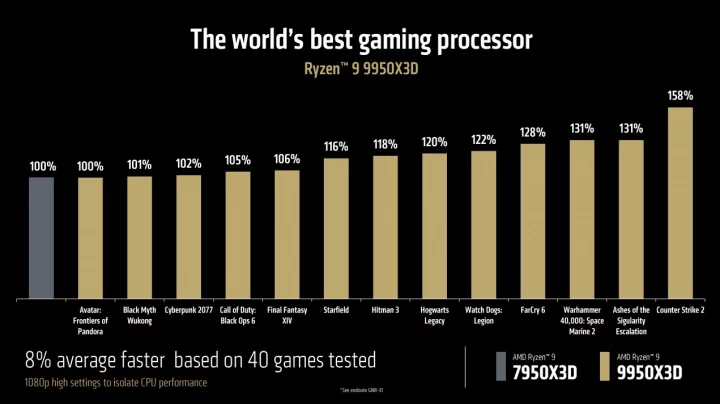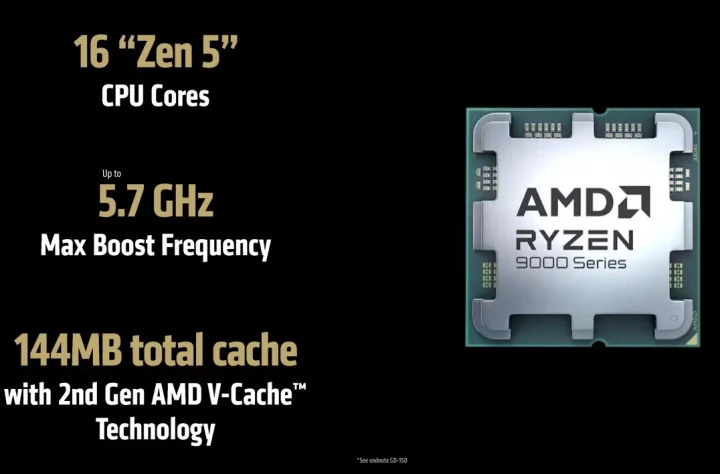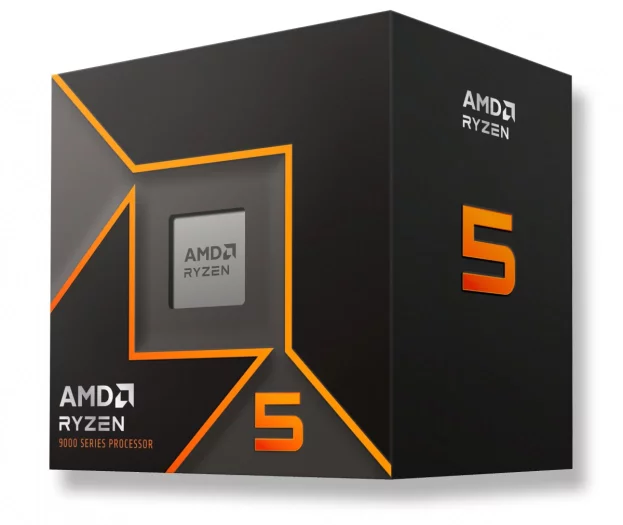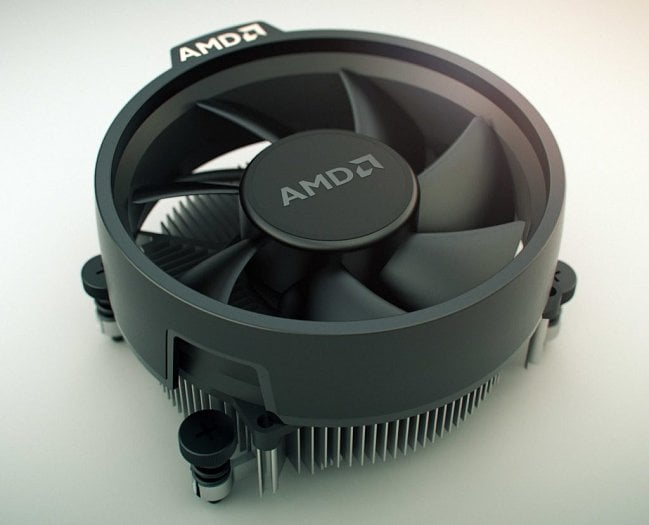Yesterday we already got a taste of some of the news that AMD presented at CES 2025, especially the most interesting new processor. But the company presented more of them. Including desktop processors for the AM5 platform. The top-of-the-line Ryzen 9000 models with 3D V-Cache were released at the show, which should now represent the best AMD has to offer in desktop PCs. But a processor is also released, bringing the Zen 5 architecture into cheaper waters.
In the fall, AMD released Ryzen 7 9800X3D, which thanks to 3D V-Cache (already in its third generation) became the fastest processor for gaming computers, surpassing all other Zen 5 models and competition from Intel in games. However, this processor is only eight-core and also has a limited frequency of only 5.2 GHz, so it does not have maximum performance in single-threaded applications and certainly not in multi-threaded non-gaming software (where AMD’s Ryzen 9 9900X and 9950X reign supreme).
“The best CPU for gamers and creators at the same time”
Now AMD is adding new Ryzen 9 9900X3D and Ryzen 9 9950X3D models to the offer, which combine both. If you’re familiar with the previous generation 7900X3D and 7950X3D models, you’re already at home, these new processors do the same thing but with the new Zen 5 architecture. They’re built with two CPU chiplets in the case, but one is replaced with the same CPU chiplet that has an added layer instead of the conventional one with 3D V-Cache (which is stored under a layer with cores, like the 9800X3D model). This chiplet therefore has a total of 96 MB of L3 cache for its cores. The second chiplet is normal, only with 32MB cache.
At first glance, this solution looks inelegant compared to the hypothetical alternative where V-Cache would be on both CPU chiplets. But it has an important consequence. The conventional chiplet does not suffer from the limitations of 3D V-Cache and it is possible to use the same high boost frequencies as the Ryzen 9 9900X and 9950X, i.e. up to 5.7 GHz instead of the limitation of approx. 5.2 GHz (model 9800X3D). The cores in this chiplet can thus be used to run application software without loss of performance.
In the multi-threaded software, cores from both chiplets with up to 32 threads are then connected, i.e. as with the Ryzen 9 9950X. Conversely, games are preferably run on cores with 3D V-Cache, where performance should reach the level of the 9800X3D model. The correct assignment of tasks to the appropriate cores is controlled by the operating system, drivers and software connected to them. We described it here:
AMD describes these new processors as solutions that deliver maximum performance for both gaming and creators. However, under the term “creators” you can add practically all application software, for which marketing now likes to use this designation in short as the “creator” segment, but basically everything that is not a game or an outright server task (for which Ryzens with 12 and 16 cores can also be used successfully). In any case, this designation means that these CPUs combine the universal application performance of multi-core (and high-clocked) processors with the gaming performance of the Ryzen 7 9800X3D.
Model
As in the previous generation, there is a choice between a full-fledged sixteen-core (Ryzen 9 9950X3D) and a version cut down to only 12 cores (Ryzen 9 9900X3D), which, however, was not very popular in the case of the 7900X3D model, and it should be remembered that even the game part with 3D V- The cache in it has only six cores.
Ryzen 9 9950X3D it has 16 Zen 5 cores with a total of 32 threads, with a base clock of 4.3 GHz and a maximum boost of 5.7 GHz (same as the 9950X) for cores without V-Cache. The frequency for game cores with V-Cache is not directly stated, but it should probably be equal to that of the 9800X3D model, i.e. around 5.2 GHz. The TDP is 170 W (which means a maximum boost consumption in multi-threaded tasks of 230 W). The L3 cache is listed as 128MB, but as mentioned, it’s 96MB for the gaming half of the cores and 32MB for the other eight cores.
The second model Ryzeny 9 9900X3D is plus or minus the same, but with a pair of cores removed in both chiplets, allowing the chips where bugs were found to be used after completion. So you have a total of 12 cores/24 threads, 6 cores with 96MB V-Cache and 6 cores with 32MB L3 cache. This processor has a TDP of 120W (and 170W should be its maximum multi-core consumption). Its base clock is 4.4 GHz and the maximum boost for applications is 5.5 GHz. Here it is a little lower than the conventional twelve-core Ryzen 9 9900X – it has a maximum officially of 5.6 GHz.
But we don’t have prices yet. The reveal at CES 2025 isn’t a release yet, and we won’t know how much the processors will cost until just before that — likely higher prices than the 9950X and 9900X, which debuted at $449 and $649, respectively. The previous generation X3D variants (7900X3D and 7950X3D) went on the market for $599 and $699, respectively.
The release will be sometime between January and March, so far AMD is only officially saying “Q1 2025”, so sometime this quarter.

AMD’s official Ryzen 9 9950X3D benchmarks (as always, caution should be taken). More slides with benchmarks from CES 2025 can be found in the title gallery
B850 boards and Ryzen 5 9600
In addition to these processors for high-end (expensive) computers, one inconspicuous novelty is also being released – Ryzen 5 9600, information about which leaked some time ago. This processor is a slightly weaker sibling of the already sold Ryzen 5 9600X and will be a bit cheaper, so the price threshold for those who want to buy a processor with the new Zen 5 architecture will be lowered a bit.
Ryzen 5 9600 it has six cores and 12 threads. The difference is that the base clock has been reduced from 3.9 to 3.8 GHz and the maximum boost from 5.4 to 5.2 GHz – so the performance drop should be in the low percent units. But the L3 cache remains 32MB and the processor is unlocked for overclocking, so you can try to change it with OC. The CPU is based on the same 4nm CPU chiplets and 6nm IO chiplets as the 9600X model, so it retains full support for AVX-512 or PCI Express 5.0.
The processor also retains the basic integrated graphics in the IO chiplet (which has 128 shaders – only 2 CUs – of the RDNA 2 architecture at 2200 MHz, but does not lack a multimedia engine). The TDP is 65W (that means a maximum boost consumption of 88W) just like the 9600X. The absence of the letter X does not mean that this model has reduced consumption directly according to the specifications.
But what the “non-X” processors have is a bundled (“box”) cooler in the package, that is, if you buy a standard retail package and not a “tray”. AMD adds the basic Wraith Stealth cooler to this processor, already well known from previous generations of processors. This is suitable for normal use, especially in games where the CPU is not fully loaded, but a larger tower cooler purchased separately will of course be a significant upgrade, especially in quiet operation. The advantage of the basic Wraith Stealth cooler, however, is that it cools the area around the socket with airflow, which can be important for boards that do not have passive coolers on the VRM (power cascade).
This processor is also expected to go on sale sometime in the first quarter, with no confirmed exact date yet. So we don’t even have its official price yet. On the market, the 9600 should usually be found for less than the 9600X, but we don’t know exactly how much. And eventually it will probably change depending on how much individual processors are discounted in stores.
B850 and B840 platform boards
What else is coming (or is being announced now) with processors during CES 2025 are new socket AM5 boards with these processors – namely cheaper models with B850 and B840 chips. Chipset B850 it’s more or less the successor to the B650 chipset – it brings PCIe 4.0 support for graphics and lacks USB4 (that’s the difference against the X870). While boards with B650 chipsets may not always have PCIe 5.0 SSD support, it is mandatory for boards with B850 chipsets, they should always have at least one “Gen5” M.2 slot, so this is the main benefit of this new platform. Some boards even have a PCIe 5.0 x16 slot, but this is optional and optional.
Cheaper chipset B840 it only supports PCIe 4.0 for graphics and only PCIe 4.0 for SSD, moreover, it should no longer support CPU overclocking (which the B850 offers), but only memory. So it is somewhere between cheaper boards with the B650 chipset and the more expensive A620. What exactly are the differences in the equipment of the various chipsets for the AM5 platform and the boards connected to them, we discussed in the article linked below, if you need to know more:
Boards with these chipsets are scheduled to go on sale from January 15. It is still true that all Ryzen 7000, 8000 and 9000 processors with socket AM5 work on all older boards with X670/X670E, B650/B650E and A620 chipsets (it is enough if they have updated firmware).
But the advantage of new models can be a better PCB (sometimes they offer the possibility of overclocking the memory to DDR5-8000) or newer equipment (such as WiFi 7). On the other hand, boards with previous chipsets tend to be in stores for better prices thanks to discounts.
Source: AMD (1, 2), VideoCardz
Source: www.cnews.cz






